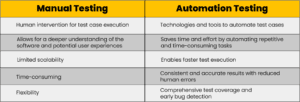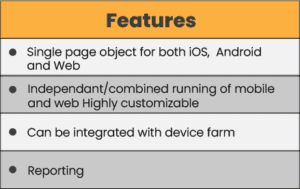June 12th, 2023
Category: Software Testing
No Comments
Posted by: Team TA

No matter the industry, organizations universally strive for quality in their products and services. This dedication to quality extends to the software they require, which must be thoroughly tested before being made accessible to their customers. The days of organizations relying entirely on manual testing are long gone. Even though manual testing is an important component of the testing process, there are a few limitations to it. It’s difficult, time-consuming, and often requires a significant investment in human resources.
Every organization focuses on software testing, as it is a critical component of any product development cycle and ensures that consumers get high-quality deliverables. And an overwhelming majority of them prefer automated testing over manual testing. The age long debate about manual vs. automated testing has been going on forever. And still, many individuals are unaware of what automation in testing means.
In manual testing, the testing team creates and executes multiple test cases and manually tests each and every feature to thoroughly test each feature of the software. If any issues or faults are identified, they are reported to the development team for resolution. This iterative procedure is repeated until a defect-free product is obtained and ready for delivery to the end user. However, manual testing is a time-intensive process that necessitates efficient management of testing activities such as meticulous planning, comprehensive bug tracking, and reliable reliability analysis.
Automation software testing, on the other hand, uses testing technologies to automate typical testing procedures by automating repetitive and time-consuming tasks, accelerating the development process, reducing costs, and improving overall efficiency. By automating various operations, companies can save valuable resources and time while enhancing the quality and consistency of their testing efforts.
While automation testing continues to evolve, businesses around the world are aiming to standardize their testing infrastructure in order to seamlessly automate their desktop, online, and mobile applications with a single tool that supports them regardless of the technologies they choose.

What is the Test Automation Framework?
Automation Framework is not a standalone process or tool; it is a comprehensive and integrated system that includes a collection of tools and processes working together to facilitate efficient and effective automated testing of applications or projects, combining various functions like libraries, test data, and various reusable modules.
Importance of Automation Framework in Software Testing
Imagine you’re building a house, and you require a collection of essential components to transform your vision into a reality. Similarly, an automation testing framework works as a crucial technical blueprint for implementing efficient automation testing practices. Let’s consider a scenario where a testing team consists of members utilizing different automation testing languages or tools. In such a situation, understanding and collaborating on the common code and scripts updated by their fellow team members within a project can become a challenge.
To address this challenge and ensure seamless collaboration, an automation framework becomes essential. It not only promotes code reuse across different scenarios but also enforces standardized test script writing practices within the team. By providing a structured and consistent approach, the automation framework becomes a reliable blueprint for the entire team to follow.
Moreover, an automation framework offers several other significant benefits, including:
- Improved code reusability
- Enhanced speed and increased test coverage
- Faster Test Development and Execution
- Easy modification of test cases, ensuring maintainability and long-term sustainability
- Continuous testing of coding and delivery will be achieved.
Test Automation Framework Types
Each test automation framework consists of its own unique architecture, accompanied by specific advantages and disadvantages. Some of these test automation frameworks include:
- Data-Driven Framework
- Keyword-Driven Framework
- Hybrid Test Automation Framework
- Data-driven Testing Framework
In the data-driven framework, test data is often obtained from external files, which can include various formats like Excel files, text files, CSV files, ODBC sources, or DAO objects. These external files serve as a source of data for the automated tests. The test script then loads this data into variables, enabling the creation of tests with different data sets.
Pros: Enables the creation of tests with multiple scenarios using a smaller number of scripts, so multiple scenarios can be tested with less code.
Cons: Implementing and utilizing the data-driven framework effectively requires testers with strong programming language proficiency.
- Keyword-Driven Testing Framework
Also known as table-driven testing, Keyword-Driven Testing Framework is an approach where automation test scripts are designed based on keywords specified in an Excel sheet or a similar format. This framework is suitable for only small projects or applications.
Pros: By using a single keyword across multiple test scripts, the code becomes more reusable.
Cons: Setting up the framework requires a high upfront investment of time and effort
- Hybrid Test Automation Framework
Hybrid Test Automation Framework combines the benefits of both Keyword Driven and Data-Driven frameworks, aiming to create a more flexible and efficient test automation solution.
Pros: Leveraging diverse framework advantages
Cons: Tests are fully scripted using keywords and data sets which increases the automation effort
All of these test automation frameworks provide a systematic and structured approach to handling code, making it easier for third parties to review. You can choose the framework as per your project requirements, team expertise, time, and budget. By adopting the framework, you can greatly enhance productivity through standardization, which ensures consistent and extensive test coverage throughout your development process, leading to better software quality and reliability.
What is TA’s Test Automation Framework?
At Travancore Analytics (TA), we have encountered significant challenges in testing projects across various platforms, such as Android, iOS, web, and others. We faced the tedious task of running individual test cases for different platforms, which prompted us to develop a comprehensive automation framework.
Our test automation framework is specifically designed to address the common struggles faced by organizations when collaborating with clients on projects involving multiple platforms. Our framework aims to provide a streamlined and efficient solution for testing across diverse platforms. With our framework, the testing process becomes seamless and time efficient. We have eliminated the need to execute test cases individually for each platform, resulting in substantial time and effort savings. Our automation framework allows the testing team to perform test cases on several platforms at the same time, including Android, iOS, web, and other platforms, ensuring consistent and reliable results.
By implementing this framework, the need for writing separate code for each platform is eliminated. Changes made on one platform are automatically reflected on others, thanks to the seamless integration of mobile and web automation within a centralized location. This eliminates the hassle of dealing with multiple testing environments and ensures an accurate reflection of Android code on the web.
One notable advantage of our framework is its flexibility, allowing teams to choose between running mobile and web automation independently or in combination, depending on project requirements. Furthermore, the framework offers a high level of customization, empowering teams to tailor it to their specific needs and preferences. Our framework seamlessly integrates with any platform, enabling efficient test execution across multiple devices and platforms. Additionally, the framework provides comprehensive reporting capabilities, ensuring that test results are well-documented facilitating easily accessible analysis and progress tracking.
Our automation framework is designed to cater to projects of any type, whether short-term with time constraints or long-term with a focus on scalability and maintainability. Regardless of the project’s duration, our framework proves to be a robust and valuable solution. With our test automation framework, organizations can achieve streamlined testing processes, significant time savings, reliable results, and enhanced collaboration across multiple platforms.

What are the Key Components of TA’s Test Automation framework?
The test automation framework, developed by Travancore Analytics, incorporates software such as Intellij, Selenium, Appium, and Extent Reports.
IntelliJ is an integrated development environment (IDE) specifically designed for Java development, although it supports multiple programming languages. It provides advanced features to enhance productivity and code quality. At the forefront of these features is its smart code editor with features like code completion, code navigation, and refactoring tools, which help automate repetitive tasks and improve code efficiency. The built-in debugger in IntelliJ IDEA is an invaluable tool for automation. It allows developers to step through their code, line by line, facilitating the identification and resolution of issues within automation scripts. IntelliJ supports various testing frameworks like JUnit and TestNG, enabling developers to run and manage automated tests directly from the IDE.
The primary tool in our framework is Selenium. Selenium is a powerful open-source testing framework widely used for automating web browsers. Selenium offers language bindings for popular programming languages like Java, Python, C#, and more, giving developers the flexibility to work with their preferred language. It also allows developers to control web browsers programmatically and interact with web elements using a rich set of methods and commands, enabling parallel execution of tests across multiple browsers and platforms, allowing for efficient cross-browser testing and distributed test execution, and also allowing users to execute automated tests without writing code.
We have also utilized Appium, an open-source framework specifically designed for automating mobile applications across various platforms, including Android and iOS. This versatile framework empowers developers to create automation tests using their preferred programming languages and test frameworks.
Our automation framework incorporates the ExtentReports Framework, which offers an excellent solution for generating comprehensive and visually appealing test reports. With this framework, teams can create beautiful, interactive, and detailed reports that effectively communicate the test results.
Overall, the combination of IntelliJ, Selenium, Appium, and ExtentReports provides a robust automation framework for both web and mobile application testing, offering a wide range of features to enhance productivity, reliability, and maintainability of automated tests.